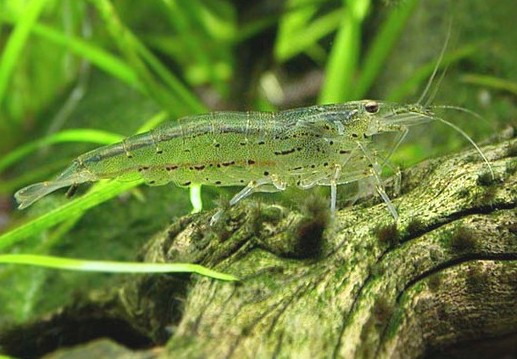Hello, Frank Indiviglio here. I’m partial to snails…from tiny stream dwellers indigenous to the spray zone of one waterfall in NY to the huge lumbering African land snails, all that I’ve worked with have been fascinating. But aquarists often have a love/hate relationship with snails, searching for one that will consume unwanted algae while not eating plants or over-populating the tank. Enter the olive nerite, a/k/a black marble or Alexander snail (Vittina usnea, formerly Neritina reclivata alexandre).
Natural History
 Amazingly, this adaptable snail, native to brackish water habitats in Florida and throughout the Caribbean and Gulf of Mexico, thrives equally well in fresh, brackish or marine aquariums. It will, however, only reproduce in brackish or marine waters, and so is an ideal choice for freshwater aquarists who fear snail population explosions.
Amazingly, this adaptable snail, native to brackish water habitats in Florida and throughout the Caribbean and Gulf of Mexico, thrives equally well in fresh, brackish or marine aquariums. It will, however, only reproduce in brackish or marine waters, and so is an ideal choice for freshwater aquarists who fear snail population explosions.
In the wild, the olive nerite ventures far up rivers, often being found miles away from the sea. It seems unlikely that such a small creature would migrate back to the ocean to reproduce, so it may breed at the river’s bottom, where denser marine waters penetrate at high tide. It is theorized that this unusual mollusk may be in the process of evolving from a marine to a purely freshwater creature.
Olive Nerites in the Aquarium
Another point to recommend the olive nerite is the fact that it feeds only upon the brown and green algae that often coats plant leaves, rocks and aquarium glass, and leaves living plants untouched. When algae populations decline, its appetite can be easily satisfied with algae wafers and Spirulina discs.
The attractive shell of marble-sized olive nerite is often colonized by tiny barnacles, adding to its interesting appearance. They are as resilient to environmental conditions as they are to habitat changes, doing well at temperatures ranging from the upper 40’s to the upper 90’s (F) and in waters of 6.3-8.4 in pH.
Related Snails
Two purely marine relatives of the olive nerite, Neritina funiculata and Vittina luteofasciata, are sometimes offered for sale as well. They have wider appetites than their more popular cousin, but do best in marine aquariums that support red and brown algae.
Further Reading
Detailed information and a key to the snails of Florida has been posted by the Florida Museum of Natural History at http://www.flmnh.ufl.edu/malacology/fl-snail/snails1.htm.
Please write in with your questions and comments. Thanks, until next time, Frank Indiviglio.
Image Neritina reclivata is of a related species, referenced from Wikipedia and originally posted by ictheostega.
 That Fish Blog – Aquarium Advice and Information
That Fish Blog – Aquarium Advice and Information


 Often brackish fish are a hard sell to people on the market to start an aquarium. Fish appropriate for brackish systems don’t tend to be as colorful or as easy to mix in communities as many other types of fish, or so many think. But though these fish are often banished to a remote corner of the fish shop, and often seem too complicated to keep, there is one fish in particular that may be the one to convince you to try your hand at a brackish system.
Often brackish fish are a hard sell to people on the market to start an aquarium. Fish appropriate for brackish systems don’t tend to be as colorful or as easy to mix in communities as many other types of fish, or so many think. But though these fish are often banished to a remote corner of the fish shop, and often seem too complicated to keep, there is one fish in particular that may be the one to convince you to try your hand at a brackish system. The following shrimps will co-exist with one another, provided the dietary needs of the specialists are met. All thrive at temperatures of 74-80 F and a pH range of 6.5-7.5. They do best in heavily planted aquariums with moderate water flow and, like many invertebrates, are very sensitive to ammonia. Many species appear somewhat social, congregating together, and most gravitate to and forage on driftwood if such is provided.
The following shrimps will co-exist with one another, provided the dietary needs of the specialists are met. All thrive at temperatures of 74-80 F and a pH range of 6.5-7.5. They do best in heavily planted aquariums with moderate water flow and, like many invertebrates, are very sensitive to ammonia. Many species appear somewhat social, congregating together, and most gravitate to and forage on driftwood if such is provided.  A hard bony carapace protects cowfish relatives from attack by many predators. However, all are slow moving, and their rapidly undulating fins seem to draw attacks from smaller fish. Oddly enough, the skin over their rigid protective plates is quite sensitive. Be sure to watch your specimens closely, lest wounds inflicted by tiny fishes go un-noticed and lead to infection or stress-related diseases.
A hard bony carapace protects cowfish relatives from attack by many predators. However, all are slow moving, and their rapidly undulating fins seem to draw attacks from smaller fish. Oddly enough, the skin over their rigid protective plates is quite sensitive. Be sure to watch your specimens closely, lest wounds inflicted by tiny fishes go un-noticed and lead to infection or stress-related diseases.